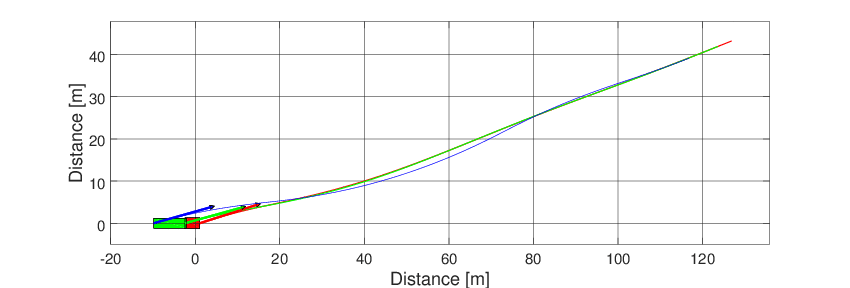Template Articulated¶
This template shows how to simulate an articulated vehicle and plot the results.
In this case, the parameters are defined by the user.
First, we define the Pacejka tire model (Pacejka (Magic Formula)).
TireModel = TirePacejka(); % Choosing tire
Then, the tire parameters are defined as
TireModel.a0 = 1;
TireModel.a1 = 2;
TireModel.a2 = 700;
TireModel.a3 = 5000;
TireModel.a4 = 80;
TireModel.a5 = 0;
TireModel.a6 = 0;
TireModel.a7 = 0.6;
Check all the tire parameters at TirePacejka.
The nonlinear articulated vehicle model (Articulated vehicle 4 DOF) is defined as
VehicleModel = VehicleArticulatedNonlinear(); % Choosing vehicle
The vehicle parameters can be changed as
VehicleModel.mF0 = 5200;
VehicleModel.mR0 = 2400;
VehicleModel.mF = 6000;
VehicleModel.mR = 10000;
VehicleModel.mM = 17000;
VehicleModel.IT = 46000;
VehicleModel.IS = 450000;
VehicleModel.lT = 3.5;
VehicleModel.lS = 7.7;
VehicleModel.c = -0.3;
VehicleModel.nF = 2;
VehicleModel.nR = 4;
VehicleModel.nM = 8;
VehicleModel.wT = 2.6;
VehicleModel.wS = 2.4;
VehicleModel.muy = 0.3;
Check all the vehicle parameters at VehicleSimpleNonlinear.
The input variables can be defined as
VehicleModel.deltaf = 0;
VehicleModel.Fxf = 0;
VehicleModel.Fxr = 0;
VehicleModel.Fxm = 0;
When the input variables are defined as a scalar quantity, the attributed value remains the same for the entire simulation span.
The System is completely defined once we attribute the chosen tire model to the vehicle object.
VehicleModel.tire = TireModel;
Choosing simulation time span
T = 7; % Total simulation time [s]
resol = 50; % Resolution
TSPAN = 0:T/resol:T; % Time span [s]
To define a simulation object (Simulator) the arguments must be the vehicle object and the time span.
simulator = Simulator(VehicleModel, TSPAN);
The default parameters of the simulation object can be found in Simulator. However, we are interested in changing the initial conditions of the simulation object. This can be done running
simulator.ALPHAT0 = 0.3; % Initial tractor side slip angle [rad]
simulator.dPSI0 = 0.25; % Initial tractor yaw rate [rad/s]
simulator.dPHI0 = 0.25; % Initial articulation rate [rad/s]
Now, we have everything needed to run the simulation. For this, we use
simulator.Simulate();
In this example, the plots of the time response of each state are no presented. For that, see Template Simple.
Frame and animation can be generated defining a graphic object (Graphics). The only argument of the graphic object is the simulator object after the simulation.
g = Graphics(simulator);
To change the color of the tractor and the semitrailer run
g.TractorColor = 'r';
g.SemitrailerColor = 'g';
After that, just run
g.Frame();
g.Animation();
Both graphics feature can be seen below.

Fig. 48 Animation of the articulated vehicle model.